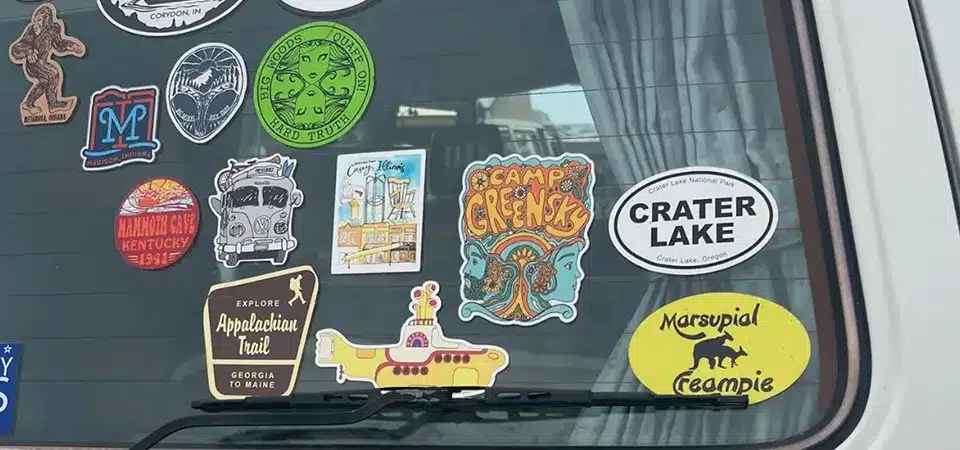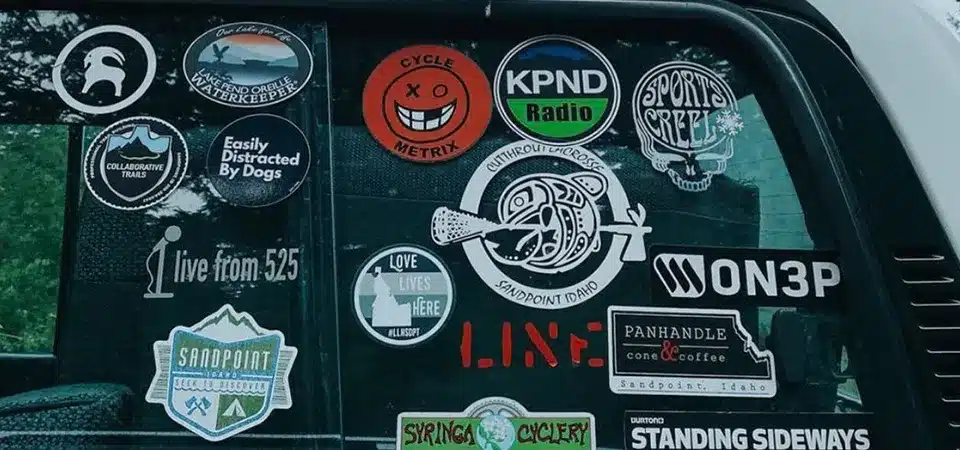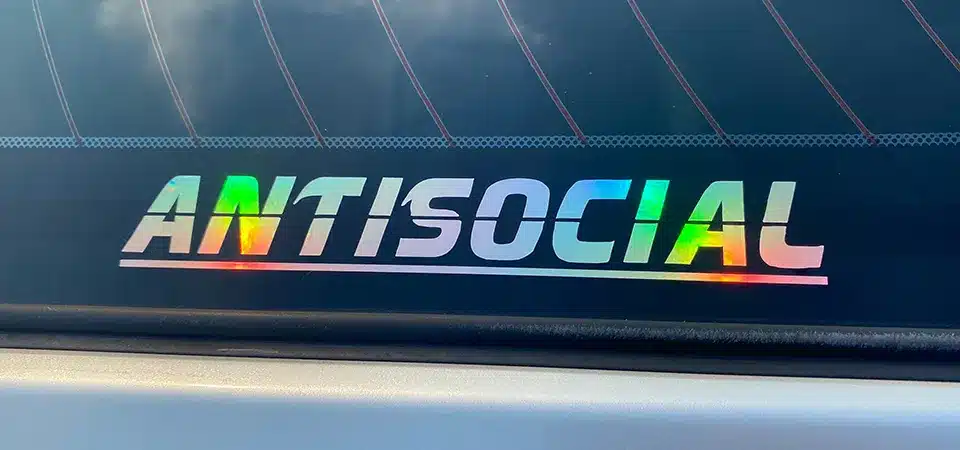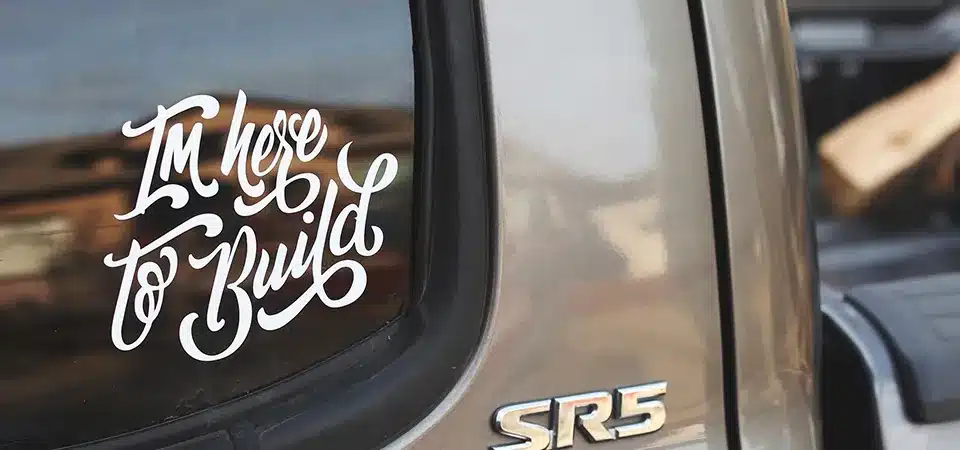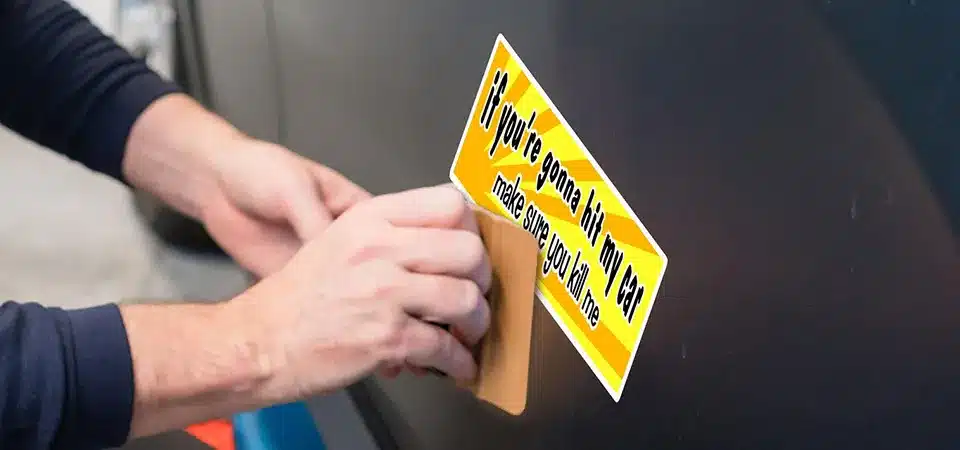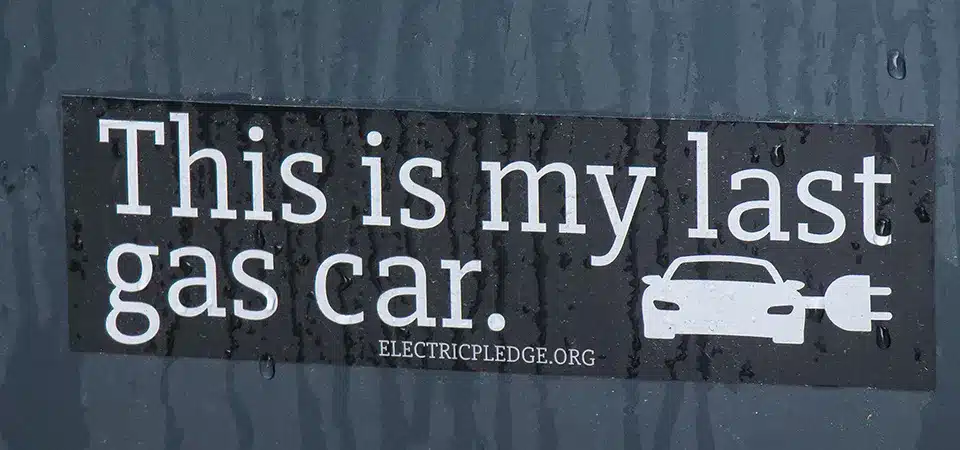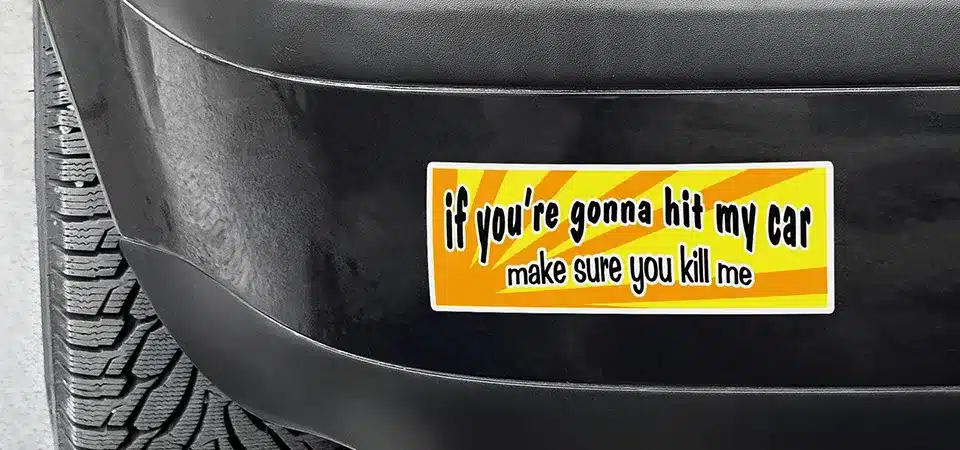Your car is a blank canvas for advertising, but a full wrap is expensive. You're missing countless local eyeballs and potential customers every single day you drive.
Branding a car involves applying custom vinyl stickers—from simple logos to larger graphics—to turn it into a mobile billboard. Success depends on a smart plan, a clear design, durable materials, and proper installation to get noticed.
As a sticker business owner in China, I've helped countless small businesses turn their vehicles into marketing machines on a budget. Unlike a full, expensive vehicle wrap, custom stickers and decals let you start small and scale up. A simple logo on a door or a phone number on the back window can make a huge impact. Done right, your car becomes a moving advertisement that works for you 24/7, delivering incredible exposure for a one-time cost. This guide will walk you through the entire process, from the first idea to the final product.
What Are Car Brand Stickers and Why Do They Matter?
Your business needs visibility, but traditional ads are costly and ineffective. Your marketing budget feels stretched thin for the little return you get from flyers or local ads.
Car brand stickers are cost-effective vinyl graphics that advertise your business on your vehicle. They matter because they create continuous, local brand exposure, turning your commute into a powerful and affordable marketing tool that builds community trust.
The single biggest reason car branding matters is its incredible return on investment. Professionals measure advertising effectiveness in "cost per thousand impressions" (CPM). A billboard or radio ad has a recurring monthly cost. Your branded vehicle, however, works for you after a single, one-time investment. Every time you drive to a job, park at the grocery store, or sit in traffic, you are generating impressions. It's especially powerful for local businesses like plumbers, bakeries, or realtors. When people in your community see your branded van around town every day, it builds a level of familiarity and trust that a social media ad just can't replicate. It sends a simple message: you are a professional and active member of their community.
How Do You Understand the Types of Car Brand Stickers?
You want to order stickers for your car, but the different vinyl types are confusing. Picking the wrong one could mean a bad look, a wasted budget, or a decal that won't last.
Key types include opaque vinyl for solid graphics, clear vinyl for "no label" looks, and perforated decals for windows. Lettering provides clean text, while die-cut stickers offer custom shapes. Magnetic options give you temporary branding.
Choosing the right material is probably the most important technical decision you'll make. The sticker you use for a solid logo is very different from the one you need for your back window. In my shop, we guide clients through these options to match their goals and budget. It's not as complicated as it sounds once you see the choices.
Here’s a simple table to help you understand the main types:
| Sticker Type | Best Use Case | Key Feature |
|---|---|---|
| Opaque Vinyl | Solid logos, colorful graphics, contact info | Most common; completely blocks what's underneath. |
| Clear Vinyl | Intricate designs on glass, "no label" look | The background is transparent, showing the car's paint. |
| Perforated Window Decals | Graphics on rear and side windows | See-through from the inside, solid graphic outside. |
| Vinyl Lettering | Business name, phone number, website | Individual letters with no background for a clean look. |
| Kiss-Cut & Die-Cut Stickers | Custom shaped logos or character designs | Cut precisely to the shape of your design. |
| Magnetic Stickers | Part-time business use, temporary promotions | Removable and reusable; not for permanent branding. |
I had a catering client who used her personal van for deliveries. She chose magnetic stickers. She could put them on for business hours and take them off when she was driving her family around. It was the perfect, flexible solution for her.
How Do You Plan Your Car Brand Stickers Project?
You're excited to start, but jumping in without a plan can lead to costly mistakes. You could end up with a design that's illegal, ineffective, or blows your budget.
Start by setting clear goals, like increasing website traffic. Then, create a budget that includes design, printing, and installation. Finally, check local laws about window coverage and ad placement to ensure you are fully compliant.
A successful project starts long before you open a design program. A little bit of planning saves a lot of headaches and money later on. Before you even think about colors and fonts, you need to answer a few basic strategic questions.
Set Your Objectives and Goals
What do you want this branding to do? The goal determines the design. If you want brand awareness, a big, simple logo is best. If you want to generate direct leads, a clear phone number and a call to action like "Call for a Free Quote" are crucial. If you're promoting a specific sale, the design will be temporary and highlight the offer. Be specific.
Consider Your Budget
Your total cost has three parts. First is the design cost (are you designing it yourself, using an online tool, or hiring a graphic designer?). Second is the printing cost, which depends on the size, quantity, and type of vinyl. Third is the installation cost (are you applying it yourself or paying a professional?). Knowing your total budget helps you make smart choices.
Check Legal Requirements & Permissions
This is a step people often forget. Most places have laws about how much of your front windshield and front side windows can be covered. There may also be rules about reflective materials. A quick search for "vehicle graphic regulations" in your local area or a call to your department of motor vehicles can clarify this.
What is the Best Way to Approach the Design Phase?
A bad design can make your business look unprofessional. A cluttered, unreadable graphic on a moving car is a complete waste of money and a missed opportunity.
Great design focuses on readability from a distance. Use bold, contrasting colors and place branding in high-visibility areas. Always use high-resolution logos and create mockups on a vehicle template before you print anything.
Your car is not a business card. People have only 3-5 seconds to read your message as you drive by. This means the rules of design are different. Simplicity and clarity are everything.
Gather Accurate Vehicle Templates/Measurements
Never design in a vacuum. Get the exact year, make, and model of your vehicle to find a professional template online. If you can't find one, take clear photos of the sides and back, and carefully measure the areas where you plan to place graphics. As we say in the print world, "measure twice, print once."
Use Strong Design Principles for Vehicles
- Readability: Use clean, bold fonts. Avoid thin, script-style fonts that are hard to read from 20 feet away.
- Color Choice: High contrast is key. Dark letters on a light car or light letters on a dark car work best. Use your brand colors, but make sure they stand out.
- Branding Placement: The most valuable areas are the back and the sides. The back gets the most viewing time from cars behind you in traffic.
- Image & Logo Resolution: Use vector files (.ai, .eps, .pdf) for all logos and graphics. This ensures they can be scaled to any size without losing quality and looking blurry.
Create Mockups
Before you commit to printing, place your design onto a photo or template of your car. This helps you see the scale, placement, and overall impact. It’s the best way to catch a design problem before it becomes an expensive mistake.
What's Involved in Printing and Production?
Your design is ready, but choosing a print shop is daunting. A bad print job will ruin a great design with faded colors, peeling vinyl, or a blurry finish.
Choose a reputable print shop that specializes in vehicle graphics. Provide a print-ready vector file, approve their digital proof carefully, and ask for a test print if your brand colors are critical. This ensures a professional result.
The quality of the print is just as important as the quality of the design. You need a partner who uses the right materials and machinery for graphics that will live outdoors on a moving object.
Choosing a Print Shop vs. DIY
For a professional look that lasts, you need a professional print shop. My shop uses durable, outdoor-rated cast vinyl and UV-resistant laminates. While a hobby machine like a Cricut is fun for crafts, the vinyl is not made to withstand years of sun, rain, and car washes. Going with a pro ensures longevity.
File Preparation & Proofing
When you send your file to the printer, make sure it is a "print-ready" vector file (usually a PDF or an AI file). Before we print anything, we will send you back a digital proof. This is your last chance to check for typos, confirm colors, and approve the cut lines. Review it with care.
Color Matching and Test Prints
Your screen shows color in RGB (light), but we print in CMYK (ink). The colors will be close but may not be identical. If you have a very specific brand color (like Coca-Cola red), ask your printer if they can do a small test print on the actual vinyl so you can approve the color before the full job is run.
How Do You Prepare the Car Before Installation?
You have your stickers, but applying them to a dirty or hot surface will cause them to fail. All your hard work and money could start peeling off in just a few weeks.
Preparation is crucial for longevity. Thoroughly clean the car surface with isopropyl alcohol. Work in a shaded, wind-free area, and make sure the surface temperature is moderate—not too hot and not too cold—for the best results.
The time you spend on preparation will directly impact how long your graphics last. You cannot skip this step. The goal is to create a perfectly clean, smooth surface for the sticker's adhesive to bond to.
Cleaning the Car Surface
First, wash the car with regular car soap and water to remove dirt and dust. Dry it completely with a microfiber cloth. Then, the most important part: wipe down the entire application area with a clean cloth and 70% isopropyl alcohol. This removes any leftover wax, grease, or oils that will prevent the sticker from sticking properly.
Temperature & Weather Considerations
Vinyl is sensitive to temperature. The ideal surface temperature for application is between 50°F and 90°F (10°C and 32°C). If it's too hot, the vinyl becomes too soft and stretchy, making it easy to warp. If it's too cold, the adhesive becomes stiff and won't bond well. Always work in a garage or a shaded area, out of direct sunlight and strong wind.
Required Tools & Workspace Setup
Gather your tools before you start. You will need:
- A plastic squeegee (many print shops include one)
- Masking tape
- A measuring tape
- A sharp hobby knife or razor blade
- A spray bottle with a few drops of baby shampoo and water (for the wet method)
What Is the Step-by-Step Process for Installation?
Applying a large sticker yourself is nerve-wracking. One mistake can create ugly bubbles and wrinkles, ruining the entire graphic and wasting your money on a new one.
Measure and mark your placement using masking tape to create a "hinge." Apply the sticker with a squeegee from the center outwards to push out air. Use a little heat for curves, trim excess, and let it cure.
Applying vinyl graphics takes patience, but it's a skill you can learn. For large or complex graphics, hiring a professional is often worth it. But for simple logos and lettering, the DIY approach is very manageable if you follow the steps.
Measuring and Marking Placement
Never try to "eyeball" the position. Use your measuring tape to find the exact spot and use small pieces of masking tape to mark the corners. For larger graphics, run a long piece of tape along the top edge of where the sticker will go. This will act as your guide.
Application Techniques: The Hinge Method
For anything bigger than your hand, use the "hinge" method.
- Position your graphic and tape it down securely on one side (top or middle). This tape is your hinge.
- Flip the graphic over on the hinge.
- Peel the backing paper away from the graphic, down to the hinge. Cut the loose backing paper away.
- Carefully lay the exposed sticky side of the graphic onto the car, using your squeegee to apply firm, overlapping strokes from the center out.
- Remove the hinge tape, and now peel the remaining backing paper off while continuing to squeegee the rest of the graphic down.
Squeegeeing and Bubble Removal
Hold your squeegee at a 45-degree angle. Every stroke should overlap the last one by about 50%. This pushes the air out to the edges. If you get a small bubble, you can often push it to the edge. For a stubborn bubble, prick it with the very tip of your hobby knife and squeegee the air out.
Curing Time and First Wash
After the graphic is applied, let it sit. The adhesive needs time to fully cure and bond with the surface. Do not wash the vehicle for at least 3-5 days.
How Do You Handle Aftercare and Maintenance?
You've installed your beautiful new graphics, but now you're worried about damaging them. Power washers and harsh automatic car washes could destroy your investment in an instant.
To protect your stickers, you should gently hand wash your vehicle. Avoid automatic car washes with harsh brushes and never aim a pressure washer directly at the edges of the graphics. Park in the shade when possible to maximize longevity.
Your car graphics are an investment, and a little bit of proper care will make them last for years. The biggest enemies of vinyl graphics are high-pressure water, harsh brushes, and prolonged sun exposure.
Cleaning a Branded Car
Hand washing is always the best and safest method. Use a soft sponge or microfiber cloth with a mild automotive soap. Never use abrasive cleaning tools or harsh chemicals like solvents on the graphics. When rinsing, use a gentle stream of water. If you must use a pressure washer, stay at least two feet away from the vehicle and never spray directly at the edges of the stickers, as this can lift them.
Longevity Tips
The sun's UV rays are what cause colors to fade over time. While we use UV-protective laminates, parking in a garage or in the shade whenever possible will significantly extend the life and vibrancy of your graphics. Every few months, check the edges of your decals to make sure none are beginning to lift.
Removing or Replacing Graphics
When it's time to change your branding or sell the vehicle, you can remove the graphics yourself. Gently heat the vinyl with a hairdryer or heat gun. This will soften the adhesive. Once it's warm, you should be able to slowly peel the vinyl off. For any leftover adhesive residue, use a specialized adhesive remover (like Goo Gone) and a plastic scraper.
Conclusion
Branding your car with stickers is an affordable, powerful marketing tool. With careful planning, a clean design, and proper installation, you can create a mobile advertisement that works.


